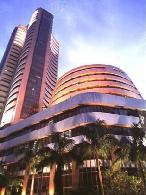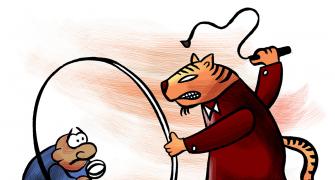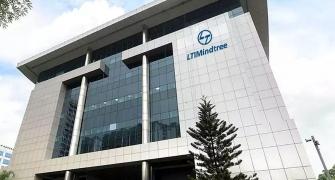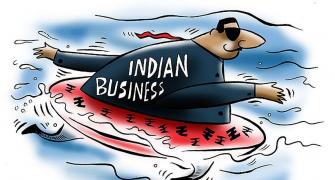 Inflation, a number of large issues and high valuations may weigh on indices; Sensex expected to trade at a historical average P/E of 15 on FY11 earnings.
Inflation, a number of large issues and high valuations may weigh on indices; Sensex expected to trade at a historical average P/E of 15 on FY11 earnings.
The coming year is expected to generate positive returns for investors, though the stock markets will not rise as sharply as they did in the months after March 9, 2009. This year was the best since 1991, with benchmark indices rising over 100 per cent from their March lows.
At 17,400, the 30-scrip BSE Sensex is trading at a price to earning (P/E) multiple of over 22 based on trailing 12 months net profit. The P/E ratio is expected to come down to around 19 based on the basis of the estimated net profit for 2009-10.
The Sensex is expected to trade at a historical average P/E of 15 by the end of the financial 2010-11 as foreign and domestic equity analysts expect India Inc's net profit to grow 25-30 per cent in 2010-11.
According to analysts, the market is fairly valued at a P/E of 19 times according to estimated earnings for 2010-11 and 14.8 times for 2011-12.
An analysis by Motilal Oswal indicates that despite the expected 25-30 per cent growth in net profit of the Sensex companies in 2011-12, the index is unlikely to cross the earlier peak of 21,000 in the next 12 months.
Concerns over inflation, a number of large issues and high valuations will limit any significant market upmove, despite a fairly healthy earnings outlook.
After a two-year earnings growth holiday in 2008-09 and 2009-10, analysts expect the Sensex earnings per share to clock 29 per cent growth in 2001-11. Beyond that, it should revert to its long-term average growth rate of 15-20 per cent.
Analysts at Credit Suisse indicate that the first quarter will be choppy as exit of fiscal and monetary stimulus and concerns over global asset bubbles weigh on investor sentiment.
They expect the 2010-11 to be the year of execution of some key long-awaited reforms. The base case December 2010 scenario for the Sensex is 19,000.
If earnings growth were to accelerate further, a P/E re-rating to 17.5 times may see the Sensex attempting to touch our optimistic target of 22,000 by the end of the year.
A Merrill Lynch analyst has indicated that valuations are getting expensive, though they are not yet in the bubble territory.
The markets are trading at 19 times one-year forward earnings well ahead of the long-term average of 14.7 times. The supply of paper will continue to be huge (over Rs 100,000 crore in 2010 if markets are bullish).
This will absorb excess liquidity and keep secondary markets in check. Rising oil prices could be a worry. Inflation, expected to be around 8 per cent by March 2010, has historically been negative for the markets.
Since 1990, there have been seven occasions when inflation has shown a long upward trend. In five of these, the markets have given negative returns in subsequent periods.
The Reserve Bank of India has been signaling an end to its easy monetary policy. A rise in the inflation rate will most likely lead to a hike in the cash reserve ratio or the repo rate in January.
Moreover, it is expected that the government will withdraw some of the stimulus measures it has provided over the past year by possibly raising excise duties. The primary offers will absorb liquidity. So, can the markets hit their all-time high in 2010?
Easy liquidity conditions globally lead to an asset bubble. There is little chance the markets will sustain at these levels in 2010.
On the two occasions that the markets have fallen more than 50 per cent, it took 294 and 571 days, respectively, to hit the old peak. This means we should hit the peak between May 2010 and June 2011.
Interestingly, on both these occasions, the markets gave a 30-40 per cent negative return in the next six months. The Indian stock market is benefiting from a growing domestic investor base. Also, insurance companies, now well developed, are offering unit-linked products, which are boosting retail participation.
After trading in the range of 15,100-16,000 between the middle of July and September 7, the BSE Sensex has crossed and closed above the upper band.
Not only has the Sensex doubled from its multi-year lows (on March 9), even the P/E has jumped over 100 per cent from 10.9 times in March to 22 times now.
The Sensex has outperformed the world markets with only Hang Seng coming close to it with a return of 74 per cent. The markets in Europe, the US and Japan have given almost half the returns than the Sensex.
The net profit of Sensex companies, based on research reports available in November-December 2009, is expected to grow 11 per cent in the current financial year over the net profit in financial year 2009. The net profit is estimated to grow 25 per cent in 2010-11.
Equity analysts expect cement, information technology, metals and telecom sectors to post moderate earnings in 2009-10. Banks, capital goods, construction, capital goods, fast moving consumer goods (FMCG) and refining companies are expected to show a robust growth in 2009-10 forward earnings.
Interestingly, the growth in Sensex earnings in 2010-11 will be driven by commodity stocks, with Hindalco, Sterlite, Tata Steel and Reliance posting a net profit growth of 30-60 per cent. The net profit growth is expected to robust for Tata Motors and DLF.
Cement, telecom and engineering will drag the aggregate earnings growth relative to 2009-10 while FMCG and information technology firms are expected to post a modest net profit growth.
However, even at the forward profit for 2010 and 2011, as many as 12 stocks are currently trading above 20 times their estimated earning for those two years. The cheapest stock based on two years forward earnings could be Grasim Industries, ONGC, Sterlite Industries and Tata Steel, which are trading at a P/E of below 10 times the estimated earnings for 2011.
The forward P/E of Sensex stocks such as ACC, BHEL, HDFC Bank, Hindustan Unilever, ITC, Infosys Technologies, Jaiprakash Associates, Larsen & Toubro, Sun Pharmaceuticals, TCS and Wipro is over 20-25 times their forward earnings.
The Indian market has shown a high correlation with net institutional flows in the secondary market over the past few months. It has performed exceedingly well in months when net institutional investment in the secondary market has been large, say analysts at Kotak Securities.
For example, the Sensex rose 28 per cent in May 2009 and 9 per cent in September 2009, when foreign institutional investors (FIIs) pumped in over Rs 13,000 crore (Rs 130 billion), according to provisional data by BSE and NSE. However, the Sensex lost 3.55 per cent in June 2009 and 7.32 per in October 2009, when FII net inflows were negligible or negative on these two exchanges.








